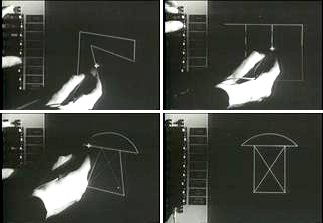We talk a lot about CAD here at SolidBox, but rarely in the context of what CAD actually is, and why SolidBox is the best possible solution for the demands of it. Computer-aided Design (CAD) as we know it today is vast and interactive. But it didn’t start that way. In fact, we’re just now reaching the maturity of several key players in the CAD world, most notably SOLIDWORKS, to where easily interacting with models that are generated by a computer, and collaborating with other designers is just now becoming possible on a large scale.
The Origins of Computer-aided Design (CAD)

Ivan Sutherland at MIT demonstrating Sketchpad
The origins of Computer-aided Design (CAD) take us back to the early 1950s, when circuitry developed during WWII became easily accessible after the war. The folks at MIT designed Sketchpad: the first computer capable of capturing data input and translating that data into images, modifiable in orientation and scale through programming. Innovations in computer circuitry in the 1960s and 1970s yielded software that could render 3D wireframe geometry, but the cost of computers limited the proliferation of CAD severely. Only the likes of GM, Lockheed, Boeing, Ford, Citroen, and other massive companies could afford the hardware, software, and workforce with the expertise to run them.
By the 1980s, the cost of cheap and reliable micro-circuitry began to drive down the cost of computers, while computing power skyrocketed compared to the previous two decades. 1981 marks the beginning of Unigraphics and CATIA. Autodesk quickly followed in 1982. Designers now had full-on solid modeling software that ran on affordable(ish) computers, and this design technology began to trickle down into other product design-cycles other than aerospace and automotive. Once Pro/ENGINEER hit the scene in 1987, the whole design/manufacturing community was happy to accept Computer-aided Design (CAD).
The Advent of Affordable Computer-aided Design (CAD) Software

Windows 95 Welcome Screen
Fast forward to the mid-90s, when Microsoft brought the personal computer into the homes of millions of first-time computer owners thanks to the usability of Windows ‘95. SOLIDWORKS broke onto the scene in November of 1995 in the wake of Windows ‘95. The goal was to marry a full-fledged, ultra-affordable Computer-aided Design (CAD) software with the now-ultra-affordable PCs that were showing up on more and more people’s desks. SOLIDWORKS was an instant hit and has since taken over as the industry leader.
Even back in 1995, SOLIDWORKS was asking a lot of PCs of that generation. The graphical needs of designers have grown even more since then. Subsequently, the circuitry of computers continues to shrink in size and expand in power. However, the modern designer has more options than ever, complicating things all the more. It’s no surprise that most IT professionals struggle with spec’ing the right hardware for the job. And even when they do, they struggle to support it when SOLIDWORKS doesn’t quite do what you expect. This is the precise reason why SolidBox exists.
SolidBox Begins to Build Computer-aided Design (CAD) Hardware
 SolidBox takes the guesswork out of finding the right computer for the right task. Everyone’s job has different requirements, and SolidBox takes those differences into account when building a PC for your team. We closely watch the system requirements for SOLIDWORKS, Mastercam, and AutoCAD to ensure our CAD Hardware meets and exceeds these baselines. We have configurations to hit every aspect of the SOLIDWORKS workflow. Furthermore, we become your IT team for all SolidBox hardware you bring in house. Hardware support from SOLIDWORKS experts, plus the peace of mind knowing that your workstation won’t be the weak link in your Computer-aided Design (CAD) workflow— That’s the SolidBox Difference.
SolidBox takes the guesswork out of finding the right computer for the right task. Everyone’s job has different requirements, and SolidBox takes those differences into account when building a PC for your team. We closely watch the system requirements for SOLIDWORKS, Mastercam, and AutoCAD to ensure our CAD Hardware meets and exceeds these baselines. We have configurations to hit every aspect of the SOLIDWORKS workflow. Furthermore, we become your IT team for all SolidBox hardware you bring in house. Hardware support from SOLIDWORKS experts, plus the peace of mind knowing that your workstation won’t be the weak link in your Computer-aided Design (CAD) workflow— That’s the SolidBox Difference.
